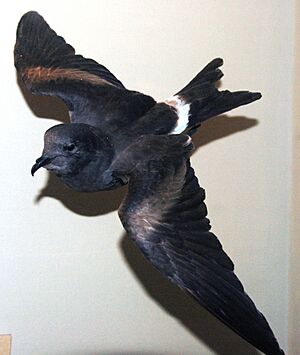Guadalupe storm petrel facts for kids
Quick facts for kids Guadalupe storm petrel |
|
|---|---|
 |
|
| Mounted specimen, Field Museum | |
| Conservation status | |
| Scientific classification | |
| Genus: |
Hydrobates
|
| Species: |
macrodactylus
|
| Synonyms | |
|
Oceanodroma leucorhoa macrodactyla W.E. Bryant, 1887 Oceanodroma macrodactyla W.E. Bryant, 1887 |
|
The Guadalupe storm petrel (Hydrobates macrodactylus) was a small seabird that lived only on Guadalupe Island. This island is located off the coast of Baja California, Mexico. Scientists believe this bird is now extinct, meaning there are no more left in the world. It was last seen breeding in 1912.
Contents
What is a Guadalupe Storm Petrel?
This bird belonged to the Hydrobatidae family, which includes many types of storm petrels. It was very similar to another bird called Leach's storm petrel. It was hard to tell them apart just by looking at them in nature. The main difference was their breeding times and slight physical details.
How to Tell Them Apart
When scientists held them, they could see small differences. The Guadalupe storm petrel was a bit bigger. It also had lighter feathers under its wings. Male and female Guadalupe storm petrels looked exactly the same.
Life Cycle and Reproduction
The Guadalupe storm petrel had a special breeding season. It laid its single egg between the breeding times of two other storm petrel species on Guadalupe Island. This helped all three species live together without competing too much for space or food.
Laying Eggs and Raising Chicks
The eggs were white with faint reddish-brown and lavender speckles. They were laid in burrows, which are like small tunnels in the ground. These burrows were about 15 inches (35–40 cm) long. They were found under the Guadalupe pine and island oak trees on top of Mount Augusta.
Most young birds had already left their burrows by mid-June. The parents likely took turns sitting on the egg for about 42 days. After the chick hatched, it probably stayed in the burrow for about 60 to 75 days. This means eggs were laid from early February to March. Young chicks would have been in the burrows during April and May. Like other storm petrels, parents fed their young only at night.
What Did Their Call Sound Like?
A scientist named Walter E. Bryant described the bird's call. He said it sounded like someone saying "here's a letter, here's a letter," with "For you, for you" repeated often.
Why Did They Disappear?
The Guadalupe storm petrel population started to shrink quickly in the late 1800s. This was mainly because of cats that were brought to the island. These cats hunted and killed many of the birds.
The Impact of Cats and Goats
In 1885, many specimens of the bird were collected. Even in 1906, the birds were still considered "abundant." However, people noticed a huge problem:
The number of birds dying because of the cats on the island was shocking. Wings and feathers were scattered everywhere around the burrows along the pine ridge.
Goats that were also brought to the island caused problems too. They ate many plants, which damaged the birds' natural home.
The Last Sightings
The last time a breeding bird was officially recorded was in 1912. After that, people only found old, empty burrows and the remains of birds killed by cats. For a long time, it was hard to be sure if the bird was truly gone. This is because the Guadalupe storm petrel looked so much like Leach's storm petrel. Also, surveys on Guadalupe Island often happened when the Guadalupe storm petrel wasn't breeding.
The Search for the Bird
From June 4 to June 10, 2000, a special search was done. Scientists looked for signs of the birds during their breeding season. They hoped to find young birds or fresh signs of recent nesting. Sadly, they found nothing.
Exequiel Ezcurra, a lead researcher, said:
We searched very carefully for the Guadalupe storm petrel, and we did not find it. Sadly, we now believe the species is truly extinct. So much effort had not been put into finding this bird since the 1920s. More than 10 researchers looked for this hard-to-find creature. It simply was not there.
Even though the bird is likely extinct, the official list of endangered species (called the IUCN Red List) still needs to be updated. Scientists usually wait a few years and do more checks to be absolutely sure.
See also
- Cryptic species complex


